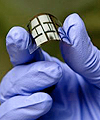By adding microscopic folds onto the surface of photovoltaic materials, a design variation borrowed from a natural leaf, researchers say they have been able to boost the solar output of flexible plastic solar cells by 47 percent. According to the scientists, who published their  findings in the journal Nature Photonics, the folds acted as a sort of “wave guide,” channeling light waves and increasing the material’s exposure to light. “I expected that it would increase the photocurrent because the folded surface is quite similar to the morphology of leaves, a natural system with high light harvesting efficiency,” said Jong Bok Kim, a researcher from Princeton University and lead author of the study. “However, when I actually constructed solar cells on top of the folded surface, its effect was better than my expectations.” And since the researchers used relatively inexpensive plastic materials — as opposed to the more expensive silicon commonly used in panels — they hope their findings will help lead to a cheaper and efficient source of solar power.
findings in the journal Nature Photonics, the folds acted as a sort of “wave guide,” channeling light waves and increasing the material’s exposure to light. “I expected that it would increase the photocurrent because the folded surface is quite similar to the morphology of leaves, a natural system with high light harvesting efficiency,” said Jong Bok Kim, a researcher from Princeton University and lead author of the study. “However, when I actually constructed solar cells on top of the folded surface, its effect was better than my expectations.” And since the researchers used relatively inexpensive plastic materials — as opposed to the more expensive silicon commonly used in panels — they hope their findings will help lead to a cheaper and efficient source of solar power.

Frank Wojciechowski
Folded solar cell